Nitro: Solana’s VM Enters The Cosmos
2022-11-15 • Sam Martin (Blockworks) , Kaleb Rasmussen, Pearce Seabrook, Arjun Mohan, Vishruth Madhusudhan
Key Takeaways:
- Solana saw significant adoption throughout 2021 as users looking to circumvent Ethereum’s high transaction fees migrated to the chain, but has hit a rough patch in the midst of the FTX/Alameda implosions.
- The EVM has become the de facto virtual machine in crypto, but Solana hopes to emulate the same success by bringing their SVM into the Cosmos ecosystem through Nitro.
- Nitro will be an L2 on top of Sei: an app-specific Cosmos chain that is optimized for DeFi through its twin consensus mechanism, frontrunning protection, and fast settlement times.
- Solana has seen a rapid decline in TVL, developer activity, and NFT trading volume, but has improved its uptime since the beginning of 2022.
The high demand for Ethereum blockspace and expensive transaction fees that ensued during the last bull run led to the rise of alternative L1s throughout 2021. Solana and its novel proof-of-history consensus mechanism was a prime beneficiary of this trend, with many users flooding into its ecosystem in favor of lower transaction fees. Ethereum was the first blockchain to support smart contracts, written in Solidity, which led to developer network effects around the EVM. Solana’s programming language is Rust, a widely known programming language, so all the success it has achieved to date is independent of the EVM’s network effects. The builders behind Solana believe Rust is a superior programming language to Solidity, and is now looking to create a standard around its Sealevel Virtual Machine (SVM). Nitro, an L2 scaling solution built on Sei, is putting this thesis to the test as it aims to bring the SVM into the Cosmos ecosystem.
Nitro allows Solana’s developer community to deploy smart contracts seamlessly into Cosmos, enabling SVM dApps to integrate with IBC connected assets. IBC stands for Inter-Blockchain Communication; an on-chain light client that allows asset and data interoperability between connected Cosmos chains. The IBC ecosystem currently consists of 50 connected chains with a total market cap of over $12B.
The Ethereum Virtual Machine (EVM) is currently the dominant Virtual Machine standard; however, the Solana and Nitro partnership has long-term implications by introducing a secondary standard built upon a high performance programming language. The introduction of Nitro will give Solana developers access to IBC connected chains. Setting the precedent of a secondary VM is also in-line with the ‘multichain future’ thesis. Their ecosystem has been hit hard by the recent FTX/Alameda blow ups, which makes the mission of creating another virtual machine standard of utmost importance if Solana wishes to capitalize on their early success.
SVM Overview:
The Solana Virtual Machine is the heart of the blockchain as it is the foundation that allows developers to write smart contracts and build dApps. The Virtual Machine is essentially a digital CPU: similar to how a CPU compiles the Java or C++ code that programmers write to bytecode (the language the computer can understand), the SVM compiles and translates Rust to bytecode to execute the smart contracts. Instead of one large-scale database or CPU that holds all of Solana’s wallets and transactions, many nodes worldwide simultaneously run the SVM. This “distributed state machine,” with around 2,000 validating nodes, keeps track of the current state of the blockchain. When a smart contract is deployed, each node receives a copy of the code, compiles it to bytecode, and shares the code with whoever calls the protocol. The SVM is the most efficient method as it functions like a physical CPU with memory and storage, but runs solely on code. However, Solana critics often point out that the hardware requirements to run a validator are too high to achieve meaningful decentralization.
Solana boasts one of the fastest transaction speeds due to the SVM’s architecture. Sealevel can process large batches as it allows parallel transactions to be processed simultaneously, increasing the number of transactions per second (TPS). Additionally, Sealevel allows for horizontal scaling with the SVM as multiple smart contracts can run in parallel without affecting one another.

Nitro and Sei Overview:
At its core, Nitro is a Layer 2 blockchain built on top of the prelaunch blockchain Sei. Blocks are produced in a similar design to other optimistic rollups, such as Arbitrum or Optimism, with a sequencer that allows for instant transactions to take place. The batched transactions are assumed to be valid when they are sent to Sei for settlement, but validators can submit fraud appeals to Sei if there is suspicion of dishonest transactions. Rust developers can port code to Nitro from Solana with minimal effort.
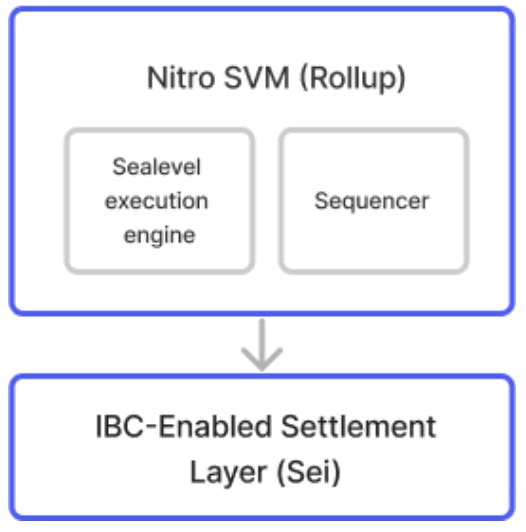
Sei is a new Cosmos blockchain, founded by Robinhood and Goldman Sachs veterans, optimized for DeFi dApps. Sei is still in testnet but has 40,000 users, a $50M ecosystem fund, and over a dozen teams already building on it. Part of that ecosystem fund went towards Nitro’s development.
Sei aims to optimize DeFi with its twin consensus mechanism, frontrunning protection, and claims to have the fastest time to finality of any chain. Sei settles transactions within 600 milliseconds and boasts a throughput of 20K TPS. A core aspect of Sei’s design is its native order matching engine which has the potential to enable new financial instruments while also increasing the efficiency of existing dApps.
Sei is designed for DEXs and plans to offer superior service through its on-chain central limit order books (CLOBs). CLOBs are used in traditional finance and on CEXs because they are more efficient than AMMs. The issue is that L1s like Ethereum aren’t fast enough to support a CLOB, so DEXs that attempt to use them operate an off-chain order book. DEXs built on Sei will be able to offer the advantages provided by a CLOB without sacrificing decentralization.
The Sei orderbook will also prevent frontrunning by aggregating every order together at the end of the block and executing the batches all at the same price. This is in contrast to Ethereum or Solana where each order is executed one by one. Additionally, monolithic L1s silo themselves in their own ecosystems due to limited interoperability and insecure bridging processes. When Sei launches it will have access to all IBC assets. Since Nitro is built on top of Sei as an L2, it inherits this interoperability while maintaining the same security guarantees as an optimistic rollup on Ethereum.
Solana Overview:
Solana has the second highest number of daily active addresses next to BSC, suggesting an active ecosystem. It averaged around 500k accounts; down nearly 50% since March, but flat on the year. It is worth noting that with such low transaction fees on Solana, these numbers may be inflated by bot and spam activity.
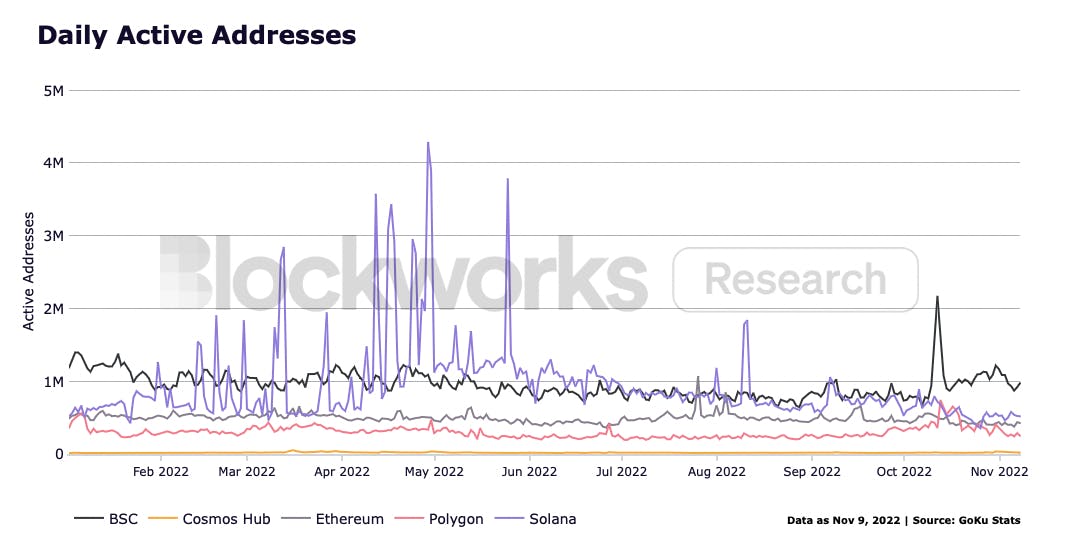
Developer activity is down nearly 90% on Solana over the past year. This is quite poor relative to the general crypto market which is down roughly 75%. Commits are relatively easy to inflate due to the open source nature of crypto, so these metrics should be taken with a grain of salt. Developer activity is down across all general purpose smart contract layers, with Avalanche and BSC taking the biggest hits. Developer activity is an indicator of future success: if there are no new dApps being developed today, there will be few applications for users to interact with tomorrow. This trend does not bode well for Solana, with the ecosystem’s TVL down over 95% from its high’s in dollar terms.
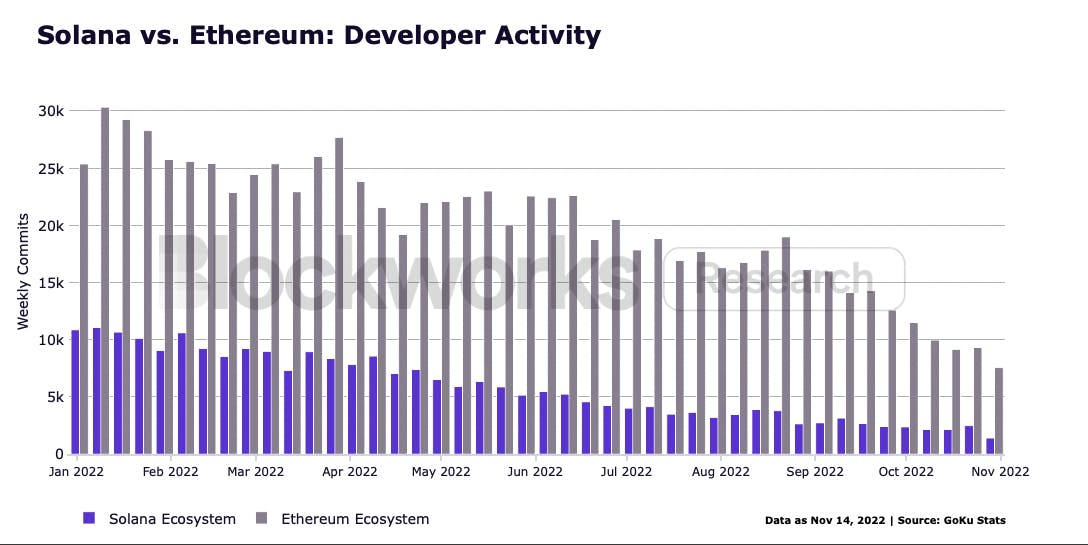
Performance:
Solana as a chain has been improving performance over time. In October of 2021, Solana consistently averaged 2500 TPS. Since then, Solana improved to an impressive 3985 TPS as of October 18, 2022. Historically, one of the biggest problems for Solana has been downtime. Over the past 12 months, the Solana network has experienced degraded performance for a total of 108 hours. Although this is still 99.6% uptime, leveraged players can be negatively impacted during times of degraded performance.

NFTs and DeFi:
One of the most compelling areas of growth on Solana has been NFTs, but Ethereum NFT trading volume still dwarfs that of Solana. However, Solana is firmly in second place with ImmutableX trailing in third by a wide margin. In terms of DeFi activity, Solana was already struggling to gain traction even before the collapse of FTX and Alameda. Two of the three largest dApps on Solana by TVL are liquid staking derivative protocols, which is concerning when taking into account that Solana was built with DeFi as its main value proposition. When looking at native token denominated TVL, Solana’s TVL has dropped 33% over the last twelve months versus 25% and 23% for BSC and Avalanche respectively.
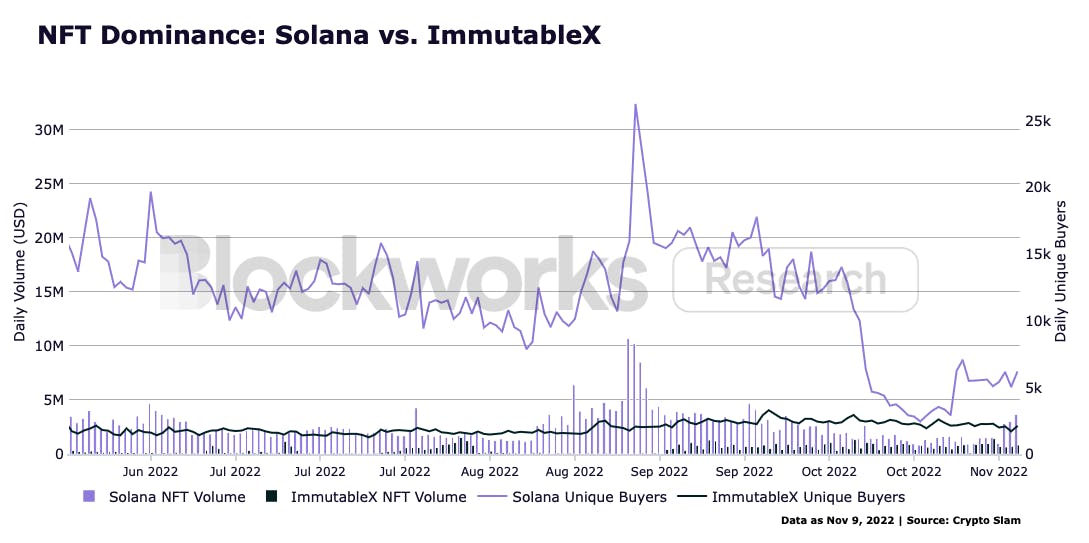
Cosmos Overview:
The Cosmos ecosystem has a TVL of over $1.4 billion with most of this TVL being concentrated on Cronos, Kava and Osmosis. Prior to its collapse, Terra had the highest TVL of all Cosmos chains with an all-time high of $21B locked (91% market share). Terra’s algorithmic stablecoin, UST, had spread far throughout the Cosmos ecosystem.
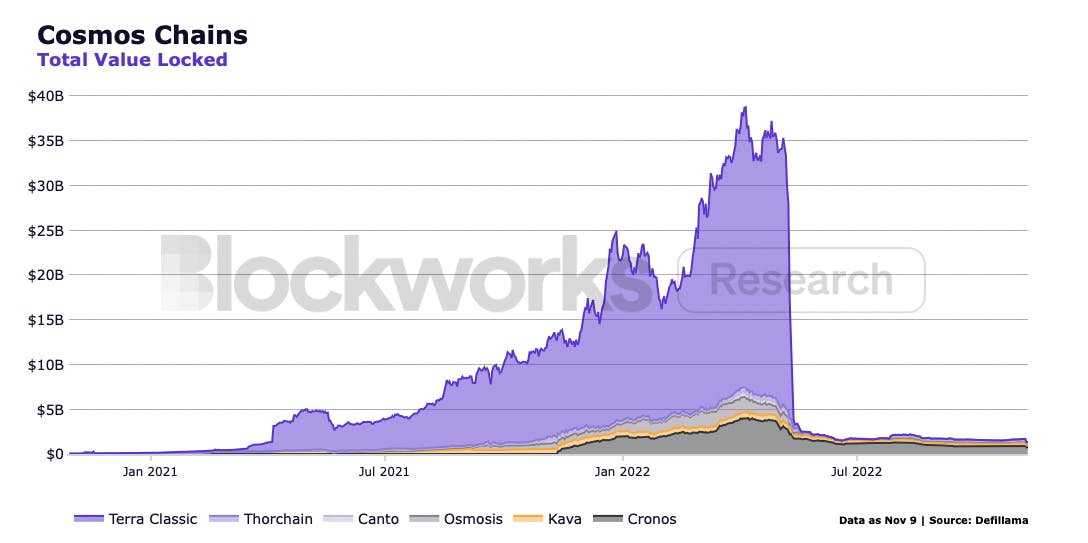
The Cosmos ecosystem has been able to maintain a relatively stable TVL in dollar terms since the collapse of Terra, despite the downward trending market: a testament to its durability.

Cosmos developer activity has remained more stable compared to other alt L1s, although there is a consistent downtrend. The decline of developer activity on Cosmos’ sub-ecosystem can likely be attributed to the broader bear market and the aforementioned demise of the Terra ecosystem. However, Cosmos is quite optimistic about onboarding more chains, which will certainly help to bring about more developer activity. Notably, dYdX opted to move away from an app-specific chain on StarkEx and become their own app-specific Cosmos chain in an effort to prioritize sovereignty and decentralization.

SVM vs EVM on Cosmos:
The Ethereum Virtual Machine has maintained a monopoly regarding VMs, supporting a thriving ecosystem of users and applications on top of various chains. The Ethereum Virtual Machine on Cosmos and other L1s offers multiple benefits: increased composability, deploy EVM-based projects seamlessly onto other chains, and exposure to new sets of users and their assets. Higher-level languages such as Solidity are compiled into bytecode and executed by the Ethereum Virtual Machine to allow transaction and block propagation to nodes. Solana’s partnership with Sei and their L2, Nitro, has offered an alternative through Solana’s SVM. Although this is not a panacea for Solana, it does present a path for growth and sets a precedent for the SVM to migrate to other chains.
There are 2 examples of successful EVM deployments in the Cosmos ecosystem: Cronos and Canto. Cronos is the largest app-chain with over $660M of TVL and 85 dApps. Canto is the 4th largest app-chain with over $200M of TVL and 5 dApps. Together they compose more than 55% of all TVL in the Cosmos ecosystem, which makes the case for VM deployments on app-specific chains. In lieu of the carnage seen on Solana in recent weeks, it makes a lot of sense for developers to deploy their applications on an L2 that settles to an app-specific Cosmos chain to avoid the fallout effects of the FTX/Alameda bankruptcies.
Multichain Future:
Ethereum bulls believe that a majority of user activity will take place on L2s in the future. The SVM is betting on a multichain future, or the idea that there will be multiple interoperable blockchains and many virtual machine standards. Each isolated chain will add value to the overall ecosystem through their specialized use cases. Developers who build dApps will choose a chain to fit their specialized needs. Sei, as discussed before, is a prime example of this having optimized for DeFi.
However, in a multichain world where chains are optimized for specific purposes, it may not play out in Solana’s favor. As discussed before, Nitro may be a positive for the wider SVM ecosystem, but it remains to be seen how it could affect the Solana blockchain directly. Ethereum was the first blockchain to support smart contracts and was able to bootstrap a community of diehard investors and builders. It is unclear if the Solana blockchain has established the same network effects. For example, while Uniswap could port its dApp to all other EVM chains quite easily, it doesn’t for every chain. Solana may have to specialize and compete with other SVM chains for TVL and dApp development, which may not benefit the SOL token.
With that in mind, Solana is not the only one affected by the multichain future. There are many broader concerns and problems that need to be solved in order for it to succeed. Today web3 has a clunky UX with siloed ecosystems. Bridging funds in a secure and user friendly manner is a problem that has yet to be solved. This has been made evident by the nearly $2B of funds lost in bridge hacks throughout 2022 alone. In addition, wrapped assets designed to improve interoperability create counterparty risk, as made clear by the FTX/Alameda backed Sollet assets which are now widely perceived as worthless as a result of their bankruptcy. There are a lot of problems that need to be solved before the multichain future can come to fruition.
Final Thoughts:
Nitro is one of the first projects aiming to build an SVM compatible chain to leverage the Solana user and developer community. It chose to do so as an L2 on top of the high performance app-specific Cosmos chain, Sei. The Cosmos ecosystem has developed key technologies used by many chains today and is attracting developer and investor attention. The FTX and Alameda implosions have left a considerable dent on the Solana ecosystem, which could make Nitro’s vision of expanding the SVM to other ecosystems critical to the Solana community’s longevity.
However, the success of Nitro hinges on a lot of external factors. Bridges represent security risks and create friction for users, L2s contain significant points of centralization, the Sei blockchain is still on testnet, and the Cosmos app-specific thesis has yet to prove itself. Additionally, Solana has seen a decline in developer activity, TVL, and NFT trading volume, and has failed to achieve its initial goal of becoming the NASDAQ of DeFi. While Nitro faces an uphill battle, their mission to expand the SVM is one that all Solana community members should be monitoring closely.
Blockchain @ Georgia Tech Socials
If you enjoyed this deep dive stay up to date with Blockchain at Georgia Tech’s upcoming events and posts by following us on Twitter and LinkedIn!
Sources
https://blockworks.co/in-nod-to-multichain-future-startup-layer-1-eyes-solana-scaling-solution/
https://www.gokustats.xyz/developers/Cosmos
https://www.gokustats.xyz/developers/Solana
https://cosmos.network/ecosystem/tokens